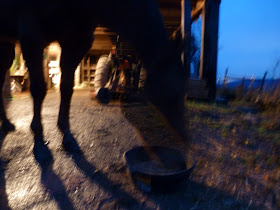This post is the hardest for me to write because I don't have any personal experience with laminitis. The previous posts were just reporting on research, this one will include some of my own opinions based on my hoof research. This opens me up to criticism, I know, so I will try to clearly label anything that is purely my opinion. Take it with a grain of salt.
Most farriers and vets believe that the hoof wall holds up the coffin bone. When a horse is afflicted with laminitis the connection of the hoof wall to the coffin bone via the laminae is totally lost, leaving the coffin bone floating around willy-nilly inside the capsule. Because of the lack of connection to the toe wall, the deep digital flexor tendon (DDFT) would then be able to pull the toe of the coffin bone downwards, where the bone can pierce the sole.
 |
| Severely foundered hoof (founder = chronic laminitis) |
Because they believe that the pulley action of the DDFT pulls the toe downwards, they try to find a way to lessen that tension. To do this, they will often prescribe that farriers either let the heels of laminitic horses grow or add pads to lift the heel.
Here's the problem I see with that scenario: The heels are raised to prevent the coffin bone from being pulled down due to stress from the DDFT, yet raising the heels mechanically forces the coffin bone onto its tip, which will then descend straight towards the sole like a spear. They've created the problem they were trying to avoid.
Another option they'll turn to are
heart bar shoes, these shoes are designed to contact the frog and make it bear some of the horse's weight. Heart bar shoes are tricky to make and even more tricky to put on, you need a very talented farrier to do it right. Not to mention that if the horse has thrush as well as laminitis this shoe might not be a very good option. Weighting a thrushy frog hurts, a lot.
 |
| Heart Bar Shoe |
Personally, I cannot understand why you would put shoes on a laminitis horse at all. It simply does not make sense to me to make the horse put all its weight on a failed structure (the laminae). That's what shoes do, they force the weight of the horse onto the hoof wall, and since the hoof wall is connected to the internal structures by the laminae, that means all that weight is transferred from the wall to the laminae- which have either given way or are in the process of doing so. Not to mention that you have to pound nails through the laminae to get the shoes to stay on (how painful must that be to a laminitic horse?).
I think heart bar shoes are terribly ironic, they are designed to take some of the weight off the walls by loading the frogs. Guess what a properly trimmed bare hoof does? Takes the weight off the walls and distributes it between the sole and frogs. So why not just leave the hoof bare and keep the walls from weight bearing at all?
Now I know that farriers have helped laminitic horses, if you've had a horse with laminitis and your farrier has been able to help your horse with shoes (like Dusty), then you've probably got a rather brilliant farrier and you should keep them and never let them get away. The problem is, from what I've heard, those farriers are few and far between.
On a positive note, there is another solution that's been catching on bit by bit with farriers that I will endorse, it's called the Steward Clog. It was created by Dr. Michael Steward of Oklahoma by accident. He had a client come to him with a severely laminitic horse and not much money. At a loss for what to do for her he did the cheapest thing he could think of and screwed a wooden shoe onto the bottom of her foot. The horse came back a few weeks later, much more comfortable and with interesting wear patterns on the wood at the toe and heel. Based on his experience with that horse, Dr. Steward came up with the idea of his clogs and horses have been doing well with them ever since.
 |
| Steward Clog |
I think the Steward Clog works well for a variety of reasons. For one, you don't have to nail it on- it can be screwed or glued onto the hoof which means no pounding from a hammer is involved; the breakover is under the foot, which greatly reduces the stress and tearing on the laminae at the toe; it covers the entire sole of the foot which allows for a greater dispersion of weight away from the laminae; and they allow the horse flexibility to find a more comfortable stance.
Here's another good thing about the Steward Clog,
the instructions are available for free online. You can make them yourself or you can
buy the premade version here. The premade clogs can be nailed, screwed, or glued to the hoof. There's no reason not to try them.
At least that's my opinion, for what it's worth.
























